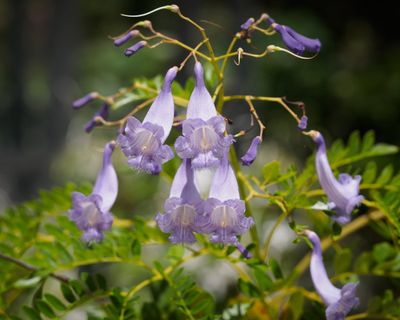Potted Jacaranda Trees
Mature jacaranda trees put on spectacular displays of blue-purple bloom clusters each spring. They are widely planted as an ornamental trees in tropical regions all over the world because of their blooms and ferny, mimosa-like foliage. When the blooms fade, the tree produces seed pods, which can be collected to propagate new jacaranda trees. The seeds germinate easily; however, it can take several years for new jacaranda plants to mature enough to produce blooms. When planted in ground in tropical to semi-tropical regions, jacaranda trees can grow up to 50 feet (15 m.) tall. In cooler climates, they can be grown as container trees that will top out at about 8 to 10 feet (2.5-3 m.) tall. Annual pruning and shaping of potted jacaranda trees will be necessary during the dormant period to maintain a size suitable for containers. The larger the potted jacaranda tree is allowed to grow, the harder it will be to move it indoors for winter and back outdoors in the spring.
How to Grow Jacaranda in a Pot
Container grown jacaranda trees will need to be planted in 5-gallon (19 L.) or larger pots filled with a sandy loam potting mix. Excellent draining soil is essential to the health and vigor of potted jacarandas. The soil should be kept moist, but not soggy, throughout the active growing season. When jacaranda trees in pots are taken indoors for winter, they should be watered less frequently and allowed to dry out a bit. This winter dry period increases blooms in the spring. In the wild, a soggy, wet winter, means less jacaranda blooms in spring. Fertilize potted jacaranda trees 2-3 times per year with a 10-10-10 fertilizer for blooming plants. They should be fertilized in early spring, midsummer and again in fall. It is also important to note that the rich blue-purple pigments in jacaranda blooms have been known to stain surfaces if flower litter isn’t cleaned up.
